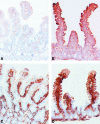The "perfect storm" for type 1 diabetes: the complex interplay between intestinal microbiota, gut permeability, and mucosal immunity
- PMID: 18820210
- PMCID: PMC2551660
- DOI: 10.2337/db08-0331
The "perfect storm" for type 1 diabetes: the complex interplay between intestinal microbiota, gut permeability, and mucosal immunity
Abstract
It is often stated that type 1 diabetes results from a complex interplay between varying degrees of genetic susceptibility and environmental factors. While agreeing with this principal, our desire is that this Perspectives article will highlight another complex interplay potentially associated with this disease involving facets related to the gut, one where individual factors that, upon their interaction with each another, form a "perfect storm" critical to the development of type 1 diabetes. This trio of factors includes an aberrant intestinal microbiota, a "leaky" intestinal mucosal barrier, and altered intestinal immune responsiveness. Studies examining the microecology of the gastrointestinal tract have identified specific microorganisms whose presence appears related (either quantitatively or qualitatively) to disease; in type 1 diabetes, a role for microflora in the pathogenesis of disease has recently been suggested. Increased intestinal permeability has also been observed in animal models of type 1 diabetes as well as in humans with or at increased-risk for the disease. Finally, an altered mucosal immune system has been associated with the disease and is likely a major contributor to the failure to form tolerance, resulting in the autoimmunity that underlies type 1 diabetes. Herein, we discuss the complex interplay between these factors and raise testable hypotheses that form a fertile area for future investigations as to the role of the gut in the pathogenesis and prevention of type 1 diabetes.
Figures



References
-
- Hooper LV: Bacterial contributions to mammalian gut development. Trends Microbiol 12:129–134, 2004 - PubMed
-
- Hooper LV, Gordon JI: Commensal host-bacterial relationships in the gut. Science 292:1115–1118, 2001 - PubMed
-
- Mazmanian SK, Liu CH, Tzianabos AO, Kasper DL: An immunomodulatory molecule of symbiotic bacteria directs maturation of the host immune system. Cell 122:107–118, 2005 - PubMed
-
- Mordes JP, Bortell R, Blankenhorn EP, Rossini AA, Greiner DL: Rat models of type 1 diabetes: genetics, environment, and autoimmunity. ILAR J 45:278–291, 2004 - PubMed
Publication types
MeSH terms
LinkOut - more resources
Full Text Sources
Other Literature Sources
Medical

